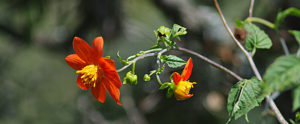
Dahlias are among the most beloved flowers in our gardens. Not only do they come in an astounding range of forms and colors, their blooming period is one of the longest: they start blooming in June and continue in flower until first frost. That longevity – and the dahlia’s ease of care – have given the dahlia the accolades it so richly deserves. What is notable here is the fact that all these hybridized varieties were developed primarily from one or two wild species during the past 200 years. The genetic potential of dahlias appears to be simply inexhaustible.
Originating from within several regions of Mexico, the dahlia belongs to the botanical order of Asterales. Its family is that of the widely-distributed composite flower (Asteraceae) that includes some close relatives, such as cosmos and bidens. The taxonomy, or classification system, of the genus dahlia once was quite complex. More than 100 species names had been attributed to dahlias, as botanists and garden enthusiasts sought to establish the plant’s distinctive characteristics. This led to considerable confusion in nomenclature and delayed proper horticultural collection.
In the course of the past half-century, some order was instituted so that wild species could be separated from hybrids. Beginning with the seminal taxonomy undertaken by American botanist E. E. Sherff, other American academicians, foremost among them Prof. Paul D. Sorensen and more recently Prof. Dayle E. Saar, have systematized the taxonomy along strictly botanical principles. Danish professors Hans V. Hansen and J. P. Hjerting also made valuable contributions to these efforts. And more recently, teams of Mexican botanists are finding new species in remote areas of the country.
We now have 42 recognized species dahlias, plus several sub-species. Following Prof. Sorensen’s systematic treatment, the genus is separate into four sections, largely along lines of plant habit. The Pseudodendron Section includes what we know as tree dahlias. The Entemophyllon Section covers short-growing species with finely divided leaves. The largest group of dahlias is Section Dahlia; it includes not only the parent of all hybridized dahlias – namely D. coccinea – but a great many taxa that have not yet been grown extensively elsewhere. And since there always is at least one in every crowd that doesn’t fit the others, Section Epiphytum holds D. macdougallii, a rare epiphytic vining dahlia growing in southernmost Mexico and in Guatemala.
The following pages list all known species and some general facts for each, together (where available) with authoritative photos of their growth habit and bloom. As more information becomes available, we will amend the pages, correct any errors, and encourage you to seek sources of species dahlias for your garden or hybridization efforts.
We are indebted to Dr. Keith Hammett of Auckland, New Zealand, whose works and scientific approach proved invaluable in that he linked the academic community with the large contingent of dahlia growers and organizations throughout the world.
